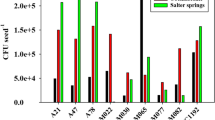Summary
The goal of breeding alfalfa for increased N2 fixation potential is addressed. A chronological progression of breeding, physiological, microbiological, and plant pathological research is described. Studies describing the interrelationships among plant morphological, plant physiological, andRhizobium effectiveness traits are summarized. It was concluded that N2 fixation in alfalfa is affected by coordinated responses among many physiological and biochemical traits. The simultaneous improvement of many factors in the symbiosis requires a comprehensive multiple-step breeding program. The current program includes selection in the glasshouse for seedling vigor,Rhizobium preference, shoot growth, nodule mass, root growth, nitrogenase (as measured by acetylene reduction), and nodule enzyme activity. The inclusion of additional selection traits is anticipated. Field evaluations of N2 fixation potential of alfalfa populations are made with15N isotope dilution techniques. Plant germplasm sources used in the breeding program include several heterogeneous populations which have good combining ability and pest resistance when they are intercrossed. Significant progress has been made in achieving the goal of breeding alfalfa for improved N2 fixation.
Similar content being viewed by others
References
Barnes D K, Heichel G H, Vance C P, Viands D R and Hardarson G 1981 Successes and problems encountered while breeding for enhanced N2 fixation in alfalfa. pp 233–248.In Genetic Engineering of Nitrogen Fixation and Conservation of Fixed Nitrogen. Eds. J M Lyonset al. Plenum Press, New York.
Barnes D K, Sheaffer C C nd Heichel G H 1983 Breeding alfalfa for improved residual nitrogen production. Agron. Abst. 54–55.
Boller B C and Heichel G H 1983 Photosynthate partitioning in relation to N2 fixation capability of alfalfa. Crop Sci. 23, 655–659.
Carter P R and Sheaffer C C 1983 Alfalfa response to soil water deficits. III. Nodulation and N2 fixation. Crop Sci. 23, 985–990.
Ellis W R and Barnes D K 1983 Characteristics ofRhizobium meliloti isolates from alfalfa in the U.S. Proceed. Eighteenth Central Alfalfa Improvement Conf. pp 15–16.
Groat R G, Vance C P and Barnes D K 1984 Host plant nodule enzymes associated with selection for increased N2 fixation in alfalfa. Crop Sci. 24, 895–898.
Hardarson G, Heichel G H, Barnes D K and Vance C P 1982 Rhizobial strain preference of alfalfa populations selected for characteristics associated with N2 fixation. Crop Sci. 22, 55–58.
Heichel G H, Barnes D K and Vance C P 1983 Nitrogen fixation of alfalfa in the seeding year. Crop Sci. 21, 330–335.
Heichel G H, Barnes D K and Vance C P 1981 Evaluating elite alfalfa lines for N2 fixation under field conditions, pp 217–232.In Genetic Engineering of Nitrogen Fixation and Conservation of Fixed Nitrogen. Eds. J M Lyonset al. Plenum Press, New York.
Heichel G H and Barnes D K 1984 Opportunities for meeting crop nitrogen needs from symbiotic nitrogen fixation. pp. 49–59.In Organic Farming. Eds. D F Bezdicek and J F Power. Special Publication. American Society of Agronomy. Madison, Wisconsin.
Jessen D L, Barnes D K and Vance C P 1983 Selection for gluatamate synthase and phosphoenolpyruvate carboxylase enzyme activities in alfalfa nodules. Agron. Abst. 68.
Nelson D L, Vance C P, Barnes D K and Heichel G H 1983 Variability for nitrate reductase enzyme activity (NRA) in alfalfa. Proceed. Eighteenth Central Alfalfa Improvement Conf. pp 14–15.
Peterson M A and Barnes D K 1981 Inheritance of ineffective nodulation and non-nodulation traits in alfalfa. Crop Sci. 21, 611–616.
Seetin M W and Barnes D K 1977 Variation among alfalfa genotypes for rate of acetylene reduction. Crop Sci. 17, 783–787.
Vance C P 1983Rhizobium infection and nodulation: A beneficial plant disease? Annu. Rev. Microbiol. 37, 399–424.
Vance C P and Heichel G H 1981 Nitrate assimilation during vegetative regrowth of alfalfa. Plant Physiol. 68, 1052–1056.
Vance C P, Heichel G H and Barnes D K 1984 Nitrogen and carbon assimilation inMedicago sativa L. mediated by host plant genes for nodule effectiveness.In Advances in Nitrogen Fixation Research. Eds. C Veeger and W E Newton. Nyhoff Publ., The Hague/Pudoc, Wageningen. pp 565–571.
Vance C P and Johnson L E B 1983 Plant determined ineffective nodules in alfalfa (Medicago sativa L.): structural and biochemical comparisons. Can. J. Bot. 61, 93–106.
Viands D R, Barnes D K and Frosheiser F I 1980 An association between resistance to bacterial wilt and nitrogen fixation in alfalfa. Crop Sci. 20, 699–703.
Viands D R, Barnes D K and Heichel G H 1981 Nitrogen fixation in alfalfa—response to bidirectional selection for associated characteristics. USDA Tech. Bull. 1643. 18 p.
Author information
Authors and Affiliations
Rights and permissions
About this article
Cite this article
Barnes, D.K., Heichel, G.H., Vance, C.P. et al. A multiple-trait breeding program for improving the symbiosis for N2 fixation betweenMedicago sativa L. andRhizobium meliloti . Plant Soil 82, 303–314 (1984). https://doi.org/10.1007/BF02184269
Issue Date:
DOI: https://doi.org/10.1007/BF02184269




